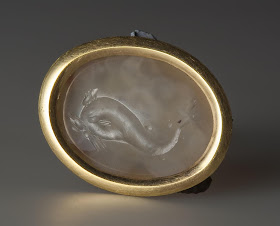 |
| Cameo - Perseus & Andromeda Roman Empire 1st century BC sardonyx Hermitage, Saint Petersburg |
 |
| Cameo - Triptolemus & Demeter with Winged Serpents Roman Empire 1st century AD sardonyx Hermitage, Saint Petersburg |
"Epicurus, then, holds that images of a sort emanate from all objects in a continuous stream, nor does a moment go by in which objects do not throw off cohesive but insubstantial trace-images of themselves; repositories for these images are located in our eyes, and that is why these sensations appropriately hasten toward the seat assigned to them by nature. These are the great man's views: if you oppose them, I look forward to learning what you have to say."
 |
| Emperor Severus Alexander Roman Empire AD 200-250 marble Hermitage, Saint Petersburg |
 |
| Portrait bust of young man Roman Empire AD 100-150 marble Hermitage, Saint Petersburg |
"Eustathius replied with a smile: 'It's clear what misled Epicurus: he diverged from the truth by relying on the analogy of the other four senses, since in hearing, tasting, smelling, and touching, we emit nothing from ourselves but receive from the outside something that moves us to perceive it. Certainly, an utterance reaches our ears on its own, and scents waft to our nostrils, and the source of taste impinges on the palate, and things that are to be perceived by touch come into contact with our body. From this he reckoned that nothing emerges from our eyes but that images of things pass on their own into our eyes."
 |
| Portrait bust of young man Roman Empire 2nd century AD marble Hermitage, Saint Petersburg |
"Against this view is the fact that in mirrors the image across from the viewer looks right back at him, though if indeed it emerges from us and sets out in a straight line, it ought to show us its back as it departs, with the left side corresponding to the left, the right to right: compare the actor who looks at the mask he's taken off from the side on which he put it on, which is to say, not the face but the hollowed out back. Next I'd like to ask this fellow whether images go flying off from objects only when there's someone who wants to see them or whether there are images darting off on every side even when no on is watching. If he should hold the former, my question is, who gives the order for the images to present themselves to the onlooker and meet his gaze whenever he chooses to look in that direction? If he should cling to the latter position, and so claim that images of all objects are flowing in a steady stream, my question then is: how long do they maintain their shapes intact when there's no substance to bind them so they stay together? Or if we should grant that they stay together, how will they retain any color, which itself though naturally incorporeal can never exist independent of a physical body?"
 |
| Intaglio - Serapis, Isis & Hermes on a Ship Roman Empire 2nd-3rd century AD jasper Hermitage, Saint Petersburg |
 |
| Intaglio - Dolphin Roman Empire 1st century AD chalcedony Hermitage, Saint Petersburg |
"Furthermore, who can convince himself that as soon as he turns his eyes, images – of heaven, sea, shore, meadow, ships, cattle, and countless things besides that we take in with a single glance – thrust themselves at him, when the pupil that is a crucial element in vision is quite small? How in the world can an entire army be seen? Do the images that emerge from the individual soldiers mass themselves and, thus marshaled in their thousands, penetrate the onlooker's eyes?'"
 |
| Head of Doryphoros Roman Empire AD 75-100 basalt Hermitage, Saint Petersburg |
 |
| Head of Youth Roman Empire 1st century AD marble Hermitage, Saint Petersburg |
 |
| Head of Athena Roman Empire 2nd century AD marble Hermitage, Saint Petersburg |
"But why belabor such an empty view, when its very emptiness is self-refuting. There is no doubt, however, that we experience vision for the following reason. An innate light flashes from the pupil in a straight line wherever you turn: if that natural emanation of the eyes should find the surrounding air to be clear, it continues straight through it until it strikes up against an object, and if you turn your face to look around, your line of vision moves straight ahead in both directions. But the emission itself, which I've said darts out from our eyes, begins from a slender base and ends by becoming broader, like rays represented by a painter: that's why the eye sees to the depths of heaven while looking through the teeniest hole."
 |
| Cameo - Sphinx Roman Empire 1st century AD onyx Hermitage, Saint Petersburg |
 |
| Intaglio - Ship's Tiller with Dolphins Roman Empire 1st century BC - 1st century AD carnelian Hermitage, Saint Petersburg |
"There are, then, three things we need to see: the light that we give off, clear air intervening, and an object for our gaze to strike against and stop; should that gaze continue on too long, it becomes tired and doesn't maintain its direction straight on but becomes split and is diffused to the left and the right."
 |
| Torso of Youth Roman Empire 1st century AD marble Hermitage, Saint Petersburg |
 |
| Torso of Youth Roman Empire 1st century AD marble Hermitage, Saint Petersburg |
Quoted passage from Book VII of the Saturnalia of Macrobius, composed in Latin around AD 430. It remained a widely popular source of general information for the European Middle Ages, continued to be quoted in the Renaissance, and is today available in a recently updated English translation from the Loeb Classical Library by Robert A. Kaster.